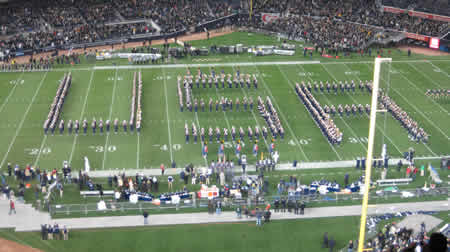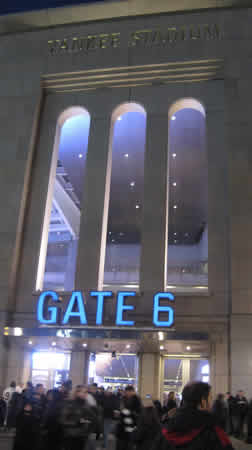
Notre Dame 27, Army 3
Saturday, November 20, 2010
New Yankee Stadium
The ND-Army rivalry at its height, during the 1940s in classic matchups — ND led by Coach Frank Leahy, and featuring Heisman Trophy winners Angelo Bertelli, Leon Hart and Johnny Lujack, against Army and its Heisman winners Don Blanchard and Glenn Davis, in front of huge crowds at Yankee Stadium, and millions nationwide.
It was a crisp, moonlit evening in the Bronx for the historic renewal of Notre Dame vs. Army — the return of the series to New York City for the first time in more than four decades — in the first college football game to be played at the New Yankee Stadium.
From virtually every perspective, Saturday’s 27-3 victory over Army at the New Yankee Stadium was a resounding success. The Irish played with determination and focus, and the entire event, from pep rallies and pre-game to the game itself, showed the best of Notre Dame to the nation. (Plus, as pre-game host Jack Nolan wryly noted, the game would be contested on a regulation field, with play going in both directions!)
Played on the site of one of America’s cultural touchstones, the game met all expectations. New Yankee Stadium is a glimmering sports palace replacing its namesake, which hosted countless memorable moments in baseball, prize fighting, and yes, football.
Notre Dame and the Yankees did an outstanding job of capturing and honoring the tradition and history of the ND-Army series, especially as contested at “old” Yankee Stadium. Everything was first-class, and the 54,251 in attendance felt honored to be witness to the renewal of such an historic legacy.
From the grainy black-and-white images of classic 80-year-old games on the Jumbotron – the ultimate paradox of old meeting new – to the presence of Heisman Trophy winners Pete Dawkins and Johnny Lujack for the coin toss, the entire scene was a celebration of the intense, respectful competition between two excellent academic institutions.
As usual, the Band of the Fighting Irish was outstanding in representing ND and creating atmosphere. Dr. Ken Dye and company put on a great show everywhere they went, and the halftime performance featuring a depiction of Gus Dorais completing a long, looping pass to Knute Rockne was one-of-a-kind. The show included a great tribute to New York and ended with a patriotic flavor that had the capacity crowd on its feet cheering. Extremely well done.
Thousands of fans jammed the subway system to travel to and from the game. It was nearly impossible to miss the historical connection, of countless folks who identify with a sports team representing a college they did not attend, but love dearly and defend. Sure, there were actual graduates aboard Saturday night, but the scene seemed to be designed for “subway alumni.”
 Coach Kelly commented later that, while he appreciates tradition and wants his players to know the great history of Irish football, it has to be in doses small enough to allow for them to concentrate on the challenge at hand. Of course, any coach has to think that way – the now is the only thing we have an affect on. Mess up and you’ll be gone.
Coach Kelly commented later that, while he appreciates tradition and wants his players to know the great history of Irish football, it has to be in doses small enough to allow for them to concentrate on the challenge at hand. Of course, any coach has to think that way – the now is the only thing we have an affect on. Mess up and you’ll be gone.
The other message implied, it seems, is that Notre Dame’s thick history of achievement on the football field can actually act as a burden on the current team, as expectations get ratcheted up to extreme levels with even the slightest sign that “the Irish may be back.”
Perhaps the reality is somewhere between the “burden” of Notre Dame football history and the glow of the years gone by. The delicate balance lies between knowing and respecting those who wore the uniforms before you, while never losing sight of the fact that today belongs to the present team and players. For many who have watched Notre Dame play these past two weeks, most agree, it’s the “spirit” that seems to have returned. What else is the Notre Dame “spirit” if not the history and tradition that wraps itself around this school and its football program?
Certainly, we all want ND to return to football prominence. What that might look like in this day and 
Today’s team will be judged by those who wear the uniform in 2010. But a tip of the cap to the history and lore of Notre Dame football is never a bad thing. Maybe the Irish of today need just a bit of breathing room….to grow into a football team everyone associated with ND can be proud of. Certainly the last two weeks have been a huge step forward.







